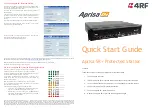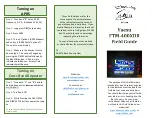
14
BE 58-602 Pulsar
®
Model R96 Radar Transmitter
2.3.3.2 Minimum Distance
If the liquid level is allowed onto the antenna, noise and
media build-up drastically decrease reliable measurement.
Liquid should not be allowed closer than 50 mm (2") from
the bottom of the antenna.
2.3.3.3 Problematic Applications; GWR Alternative
Some application concerns can be problematic for Non-
Contact Radar. For these, Guided Wave Radar is recom-
mended:
• Extremely low dielectric media (
ε
r
<1.7)
• Stillwells, standpipes, bridles, cages and bypass columns.
• Very weak reflections from the liquid surface (particularly
during turbulence) can cause poor performance.
• Tanks heavily cluttered with false targets (mixers, pumps,
ladders, pipes, etc.)
• During times of very low liquid levels of low dielectric media,
the metal tank bottom may be detected which can deterio-
rate performance.
• Foam can either absorb or reflect the microwave energy
depending upon the depth, dielectric, density and wall
thickness of the bubbles. Due to typical variations in the
amount (depth) of foam, it is impossible to quantify per-
formance. It may be possible to receive most, some or none
of the transmitted energy.
• When measurement close to flange is critical
Extremely high liquid levels (Overflow) conditions when
liquid very near the antenna can cause erroneous read-
ings and measurement failure.
Refer to ECLIPSE Model 706 bulletin BE 57-106 for
additional information.
NPT Process
Connection
BSP Process
Connection
ASME or EN Welded Flange
R96 Maximum Recommended Measuring Range in m (ft)
Turbulence
None or Light
Turbulence
Medium or Heavy
Dielectric >
1.7 - 3
3 - 10
10 - 100
1.7 - 3
3 - 10
10 - 100
Antenna Type
Dielectric Rod
5 (16)
12 (39)
20 (66)
3 (10) 9 (29)
12 (39)
4" Horn
6" Horn
10 (33)
25 (82) 40 (131)
5 (16) 12 (39)
16 (52)
50 mm (2")
Sensor
Reference
Point
Sensor
Reference
Point
Sensor
Reference
Point















































